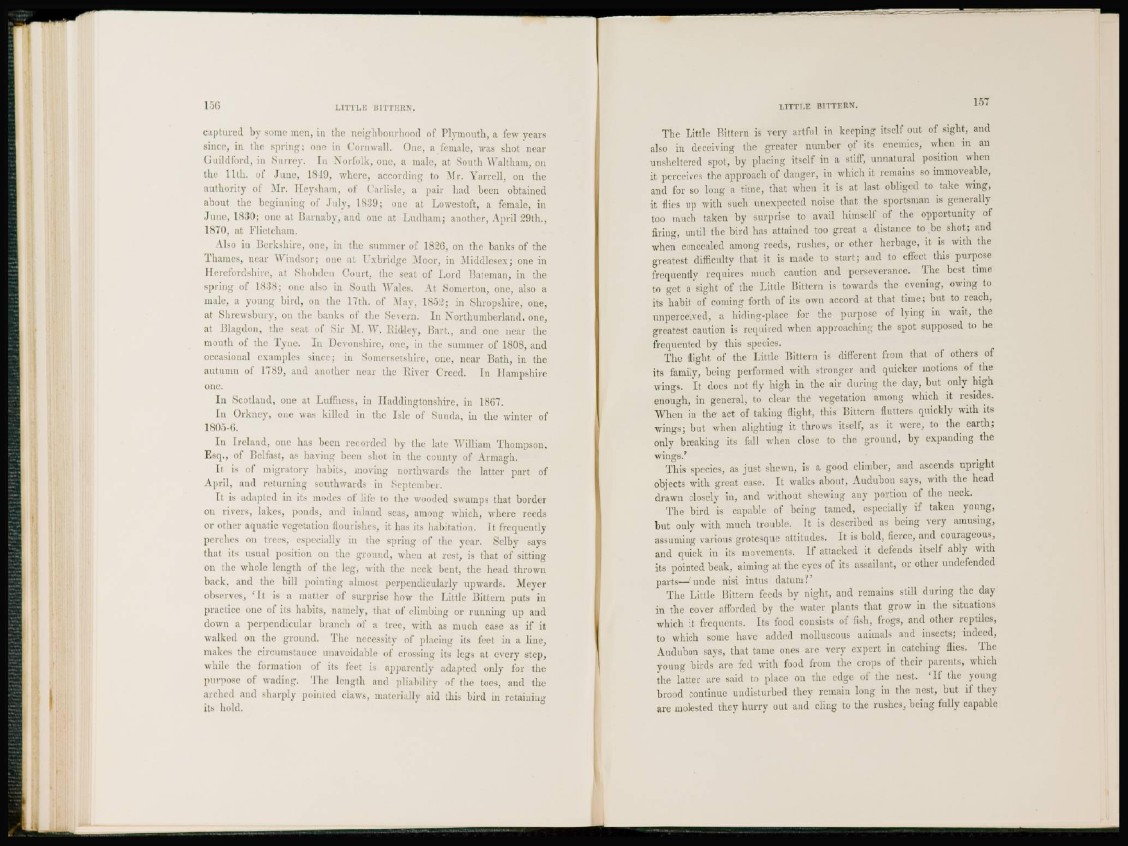
156 LITTLE BITTEEN.
captured by some men, in the neighbourhood of Plymouth, a few years
since, in the spring; one in Cornwall. One, a female, was shot near
Guildford, in Surrey. In Norfolk, one, a male, at South Waltham, on
the 11th. of .1 une, 1819, where, according to Mr. Yarrell, on the
authority of Mr. Ileysham, of Carlisle, a pair had been obtained
about the beginning of July, 1839; one at Lowestoft, a female, in
J u n e , 1830; one at Barnaby, and one at Ludham; another, April 29th.,
18*0, at Flictcham.
Also in Berkshire, one, in the summer of 1826, on the banks of the
Thames, near Windsors one at Uxbridge Moor, in Middlesex; one in
Herefordshire, at Shobden Court, the scat of Lord Bateman, in the
spring of 1838; one also in South Wales. At Somerton, one, also a
male, a young bird, on the 17th. of May, 1852; in Shropshire, one,
at Shrewsbury, on the hanks of the Severn. In Northumberland, one,
at Blagdon, the scat of Sir M. W. Ridley, Bart., and one near the
mouth of the Tyue. In Devonshire, one, in the summer of 1808, and
occasional examples since; in Somersetshire, one, near Bath, in the
autumn of 1789, and another near the River Creed. In Hampshire
one.
I n Scotland, one at Luffness, in Haddingtonshire, in 1867.
In Orkney, one was killed in the Isle of Sun da, in the winter of
1805-6.
I n Ireland, one has been recorded by the late William Thompson,
Esq., of Belfast, as having been shot in the county of Armagh.
It is of migratory habits, moving northwards the latter part of
April, and returning southwards in September.
It is adapted in its modes of Life to the wooded swamps that border
on rivers, lakes, ponds, and inland seas, among which, where reeds
or other aquatic vegetation flourishes, it has its habitation. It frequently
perches on trees, especially in the spring of the year. Selby says
that its usual position on the ground, when at rest, is that of sitting
on the whole length of the leg, with the neck bent, the head thrown
back, and the bill pointing almost perpendicularly upwards. Meyer
observes, ' I t is a matter of surprise how the Little Bittern puts iu
practice one of its habits, namely, that of climbing or running up and
down a perpendicular branch of a tree, witli as much case as if it
walked on the ground. The necessity of placing its feet in a line,
makes the circumstance unavoidable of crossing its legs at every step,
while the formation of its teet is apparently adapted only for the
purpose of wading. The length and pliability of the toes, and the
arched and sharply pointed claws, materially aid this bird in retaining
its hold.
LITTLE BITTERN. 157
The Little Bittern is very artful in keeping itself out of sight, and
also in deceiving the greater number of its enemies, when in an
unsheltered spot, by placing itself in a stiff, unnatural position when
it perceives the approach of danger, in which it remains so immoveable,
and for so long a time, that when it is at last obliged to take wing,
it flies up with such unexpected noise that the sportsman is generally
too much taken by surprise to avail himself of the opportunity of
firing, until the b i r d has attained too great a distance to be shot; and
when concealed among reeds, rushes, or other herbage, it is with the
greatest difficulty that it is made to start; and to effect this purpose
frequently requires much caution and perseverance. The best time
to get a sight of the Little Bittern is towards the evening, owing to
its habit of coming forth of its own accord at that lime; but to reach,
unperceived, a hiding-place for the purpose of lying in wait, the
greatest caution is required when approaching the spot supposed to be
frequented by this species.
The flight of the Little Bittern is different from that of others of
its family, being performed with stronger and quicker motions of the
wings. It does not fly high in the air during the day, but only high
enough, in general, to clear the vegetation among which it resides.
When in the act of taking flight, this Bittern flutters quickly with its
wings; but when alighting it throws itself, as it were, to the earth;
only breaking its fall when close to the ground, by expanding the
wings.'
This species, as just shewn, is a good climber, and ascends upright
objects with great ease. It walks about, Audubon says, with the head
drawn closely in, and without shewing any portion of the neck.
The bird is capable of being tamed, especially if taken young,
but oidy with much trouble. It is described as being very amusing,
assuming various grotesque attitudes. It is bold, fierce, and courageous,
and (puck in its movements. If attacked it defends itself ably with
its pointed beak, aiming at the eyes of its assailant, or other undefended
parts—' unde nisi intus datum?1
The Little Bittern feeds by night, and remains still during the day
in the cover afforded by the water plants that grow in the situations
which it frequents. Its food consists of fish, frogs, and other reptiles,
to which some have added molluscous animals and insects; indeed,
Audubon says, that tame ones are very expert in catching flies. The
young birds are fed with food from the crops of their parents, which
the latter are said to place on the edge of the nest. 'If the young
brood continue undisturbed they remain long iu the nest, but if thev
are molested they hurry out and cling to t h e rushes, being fully capable